
| Up to: Greetings Highlights: Summary of Greetings with Links to Source Pages |
| Previous Greetings Highlight |
| Next Greetings Highlight |
Crtd 08-11-23 Lastedit 15-10-27
Sailing
One of our mooring places, our former home mooring place, is Jinja [about our present home mooring Bunga. Kampala]. At Jinja, we are usually moored at 500 m from the source of the river Nile.

Photo direction 10o: Our Jinja mooring. Camera position: paste
in Google Earth 0.4104564 N 33.1918229 S
500 m Northward from our home mooring at Napoleon Bay we
see the Source of the Nile [More? Source page:
Source of the
Nile]
Sailing on Lake Victoria with a dhow is, technically, totally different from what western sailors in moderate climates are used to. Most of the time you will sail in Beaufort 0-3, and normally the morning wind is totally different in force and direction from the afternoon and evening wind. [More? Click Operating a Dhow].
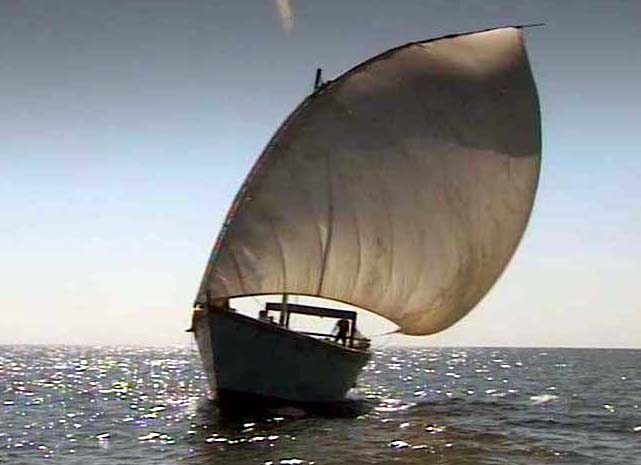
Our dhow, [More pictures of our dhow, other dhows]
The lake has thousands of small islands, and there are some very big ones. Near Jinja is Buvuma Island, 25 by 20 km. Near Mwanza, at the South side of the Lake, is Ukerewe, 42 by 20 km. But even on the smallest island, too small for a tree or even some shrubs, you will see some fishermen's huts. Fishing is done by putting or throwing nets manually, from canoes ranging from 5 to 9 meter, paddling, sailing with small lateen sails made of rags, or using very old outboards.

Photo: Jinja fishers of dagaa (tiny silverfish) going home at sunrise
Dagaa
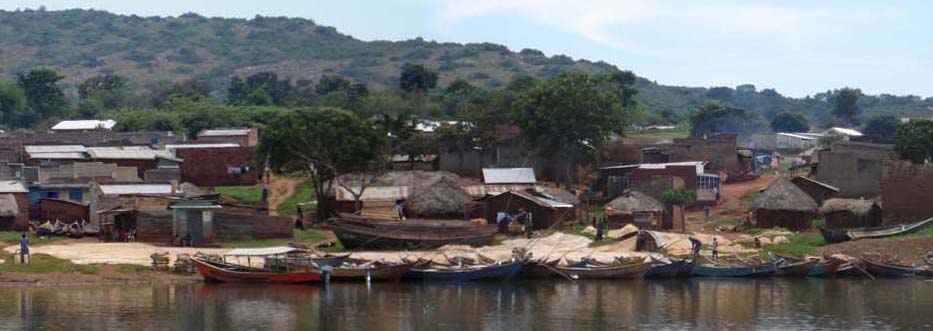
Passing a (mainly dagaa) fishing village. Full panorama (you will download the picture full size but you may have to adjust your browser to actually see full size)

Photo: Commercial navigation: Jinja fisherman
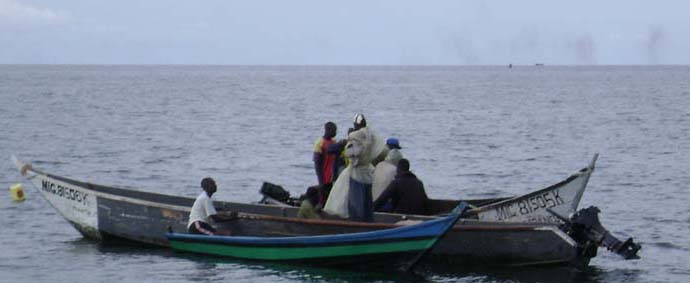
Removing fishnets from our anchor after a heavy storm
[source
page].
Behind our own canoe: typical outboard propelled fishing canoes, far right
background: towers
of lake flies
The amount of people and fishnets on Lake Victoria is astonishing. Sailing in moonless nights is hazardous because the lake is full of fishermen sleeping in their canoes to guard their nets against thieves. We estimate the total length of fishnet in the lake at any moment of time to be spanning the earth twice (80 000 km). The Nile perch is down, nowadays you will not easily witness the catch of an adult perch. Many fish factories that used to process them are now closed. Tilapia is down but still available, even adult ones, though a popular method is to catch the females breeding on the bottom of shallow shores by putting long round nets and then scaring them out of their nests by means of loud noise produced by thumping a bell shaped piece of wood on a long stick in the water surface ("thumping"). This is illegal, which means: you have to pay officials to turn a blind eye.
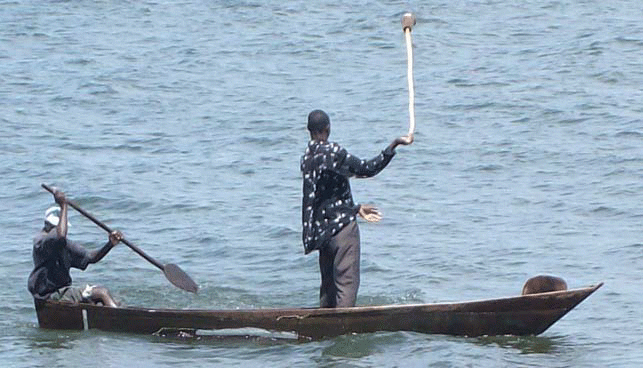
"Thumping" is generally practiced in Lake Victoria, though
some experts claim that is is illegal.
They throw a big floating net in a circle at shallow coast lines favourite among
breeding tilapia females.
The mother is scared out of the nest and in the net by the high-volume
under-water sound of "thumping". The young die.
Not exactly a way to secure a good catch in the long run!
Tilapia is declining in Lake Victoria, but not as spectacularly as the Nile
perch.
Local fish prices have in the past years risen more than the average food prices. Sailing on the Lake Victoria is essentially traveling through an ailing fish industry. The Africans are only lucky to be working totally without any advanced fishing technology because that would precipitate the process. Fish is not likely to return because the population, growing more than twice the world average, will keep concentrating around the lake simply for water needs, and maintain the frantic hunt for the remaining fish.

Musoma town (Tanzania Lake Victoria East Side) central harbour. The metal ship is permanently down, grounded and inhabited. Right: cargo dhows. Note right Vodacom, MTN and Celtel phone masts. Having a mobile phone has become normal in Africa. [source page]
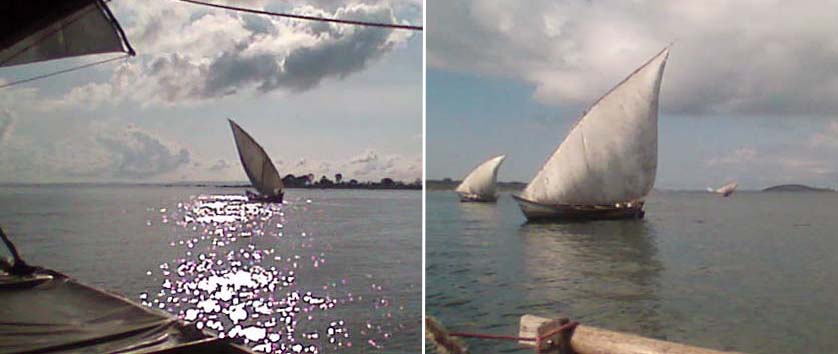
Photo Lake Victoria South coast (Tanzania): Brothers and sisters! [source page] Cargo dhows, length: 13-18 m. Ours is 18m. [More pictures of dhows]
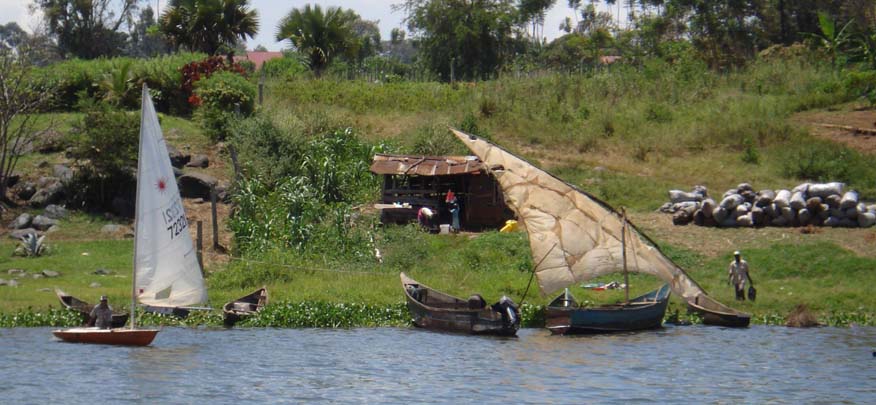
At Jinja. Right: lateen rigged charcoal trader from
the islands, 9 m. That is as long as they get in Uganda.
Left: Jinja Kingfisher Safari Lodge laser operated by Peter (a
Karamojong)
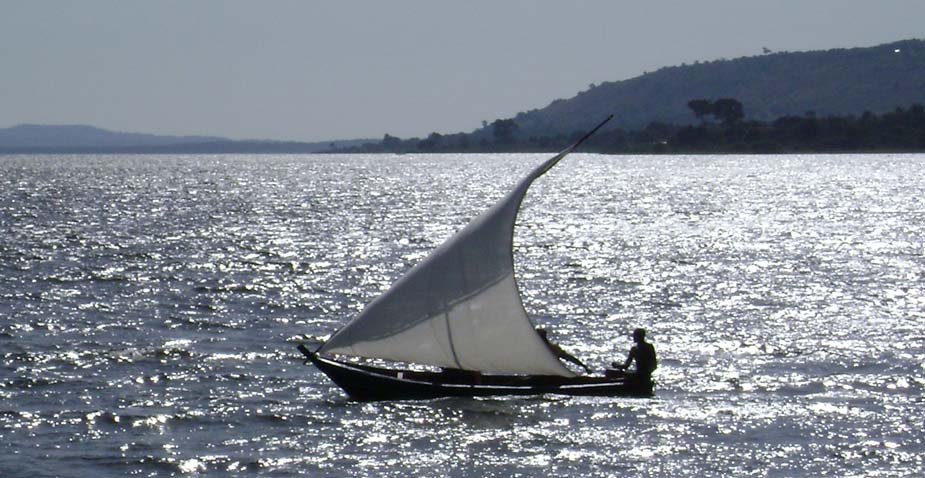
First sailing test with our own canoe [source page] [Technical page about bad canoes and outright disaster canoes] [More Lake Victoria vessel pictures]
| Up to: Greetings Highlights: Summary of Greetings with Links to Source Pages |
| Previous Greetings Highlight |
| Next Greetings Highlight |